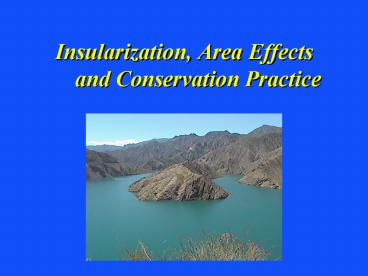Insularization, Area Effects and Conservation Practice - PowerPoint PPT Presentation
1 / 18
Title:
Insularization, Area Effects and Conservation Practice
Description:
Biogeographers have long known that as the area of any insular habitat declines, ... The suitability of species-area regressions for conservation practice will ... – PowerPoint PPT presentation
Number of Views:177
Avg rating:3.0/5.0
Title: Insularization, Area Effects and Conservation Practice
1
Insularization, Area Effects and
Conservation Practice
2
Biogeographers have long known that as the area
of any insular habitat declines, so does the
number of species it contains
- The first recorded mention of a species-area
effect was by Johann Reinhold Forster, a
naturalist on Captain Cooks second tour of the
Southern Hemisphere in 1772-1775
3
Forster noted that islands only produce a
greater or lesser number of species, as their
circumference is more or less extensive Subseque
nt studies have confirmed the species-area effect
for many groups of islands and have extended the
effect to habitat islands in terrestrial
landscapes
4
The first written recognition of the potential
negative effects of habitat fragmentation on
biodiversity was in 1855 by the Swiss
phytogeographer Alphonse de Candolle who
predicted the breakup of a large landmass into
smaller units would necessarily lead to the
extinction or local extermination of one or more
species and the differential preservation of
others
5
Theoretical ecologists have offered species-area
relationships and models of faunal collapse as
analytical tools to aid conservation biologists
in preserving species diversity
- Species-area relationships, modeled as linear
regressions, have been used to estimate the
average species number for a given area, or
conversely, the minimum area sufficient to
preserve a given number of species (or to
estimate the number of species lost as a
consequence of area lost)
6
S cAZ
or
Sp
Log S log c zlogA
S of species Aarea z a constant measuring
slope of S versus A c constant measuring
species on a given area
Area
Log Sp
Log Area
7
Galapagos Land Plants
S 28.6A0.32
S 124.8 when A 100 sq km S 59.8 when A
10 sq km
Plant Species (log)
Area (log)
8
Estimates from these regressions have served as a
basis for making recommendations concerning
optimal reserve size or for predicting losses
following fragmentationThe suitability of
species-area regressions for conservation
practice will depend upon the quality of
predictions that they generate
9
Comment on Conservation Reserves
- Today about 4.25 million km2 or about 2.5 of the
worlds land surface is protected in reserves
worldwide - IUCN calls for 13 million km2, or 8-10 of the
earths surface - a cross-section of all major
ecosystems - how these areas are selected and
protected is of the utmost importance - Although there are increasingly small
probabilities that most conservationists will
have the luxury of actually designing reserves,
we are all faced with continuing fragmentation
(and management) of habitats
10
Lets look at the explanatory power of area first
- The species-area relationship is at least partly
epiphenomenal area is confounded with many
variables, such as habitat diversity and resource
availability, that may interact and influence
species diversity - So, the explanatory power of species-area
regressions may depend on the degree of
multicolinearity between area and these other
variables
11
Explanatory power of species-area regressions
- If area is highly correlated with one subset of
these variables but only weakly correlated with
another subset, than the explanatory power of
area may be of limited utility for conservation
recommendations
12
Boecklen and Gotelli (1984)
- Looked at the 100 log-log species-area
regressions published in Connor and McCoy (1979)
as a general assay of the explanatory power of
area - On average, these models explain less than half
the variation in species number (mean 0.49,
standard deviation 0.28)
13
To determine if the species-area relationship was
better suited to some taxa, Boecklen and Gotelli
partitioned the results into taxonomic groups
14
... .. ... . . .. . . ... . .. . . . .
. ....... ... . .. . . . . .
. . . . . . . . . .
. .. . ... . .. . . .
Plants Birds Fish Insects Crustaceans Herps
Mammals
- 0.2 0.0 0.2 0.4 0.6 0.8
1.0
R2
15
Model
- Best suited to plants and birds and most poorly
suited to reptiles and amphibians, mammals,
crustaceans, fish and insects - However, the performance of the model is
unimpressive for all taxa - The inconsistent performance of these models in
explaining the variation in species number
suggests that the determinants of species
diversity are often too complex to be modeled by
area alone
16
Often a single observation can have a large
influence
- If you pull out a single point and recalculate
the slope and intercept of your regression you
can estimate the influence of single observations
17
e.g., Boecklen and Gotelli present influence
functions for Kitchener et al.s (1980)
species-area regression of Australian lizards
- They calculate that the minimum area required to
preserve all 45 species would vary from 44.2 X
106 to 3.7 X 109 ha following the deletion of a
single observation - This range encompasses areas equivalent to Texas
and the African continent!!!
18
So, species-area models cannot reliably determine
area requirements for a given number of species
- In addition to their predictive shortcomings,
these models ignore species identity, habitat
heterogeneity, and population sizes - More specific consideration of habitat
requirements, minimum area, disturbance regime,
population size, social and economic constraints
and human impact will surely improve reserve
design - The performance of species-area regressions
mandate that they be subordinate to these
considerations in policy formulation





















![Eleanor McGregor [Director: Conservation] PowerPoint PPT Presentation](https://s3.amazonaws.com/images.powershow.com/8026054.th0.jpg?_=20160801045)









